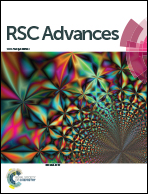Construction of three-dimensional CuCo2S4/CNT/graphene nanocomposite for high performance supercapacitors†
Abstract
The search for safe and efficient energy storage systems continues to inspire researchers to develop new energy storage materials with excellent performance. Graphene-based three-dimensional (3D) nanostructures are interesting to supercapacitors (SCs) because of their high surface area, ample number of active sites, and good conductivity. This combination of attributes allows for full utilization capacitance of active electrode materials. Herein, three-dimensional CuCo2S4–g–CNT structure was fabricated successfully with the hydrothermal method. Serving as the active electrode, CuCo2S4–g–CNT demonstrated a remarkable specific capacitance (504 F g−1 at the current density of 10 A g−1). Moreover, the as-obtained CuCo2S4–g–CNT hybrid electrode is robust, exhibiting exceptional cycle life, as revealed by galvanostatic charge–discharge studies (retaining 92.3% after 2000 cycles). Its durability is mainly due to the synergistic effects of CuCo2S4, graphene and CNTs. These unique nano-architectures demonstrate potential applications in energy storage electrodes and may indeed spur a new generation of hybrid SCs to bridge the energy gap between SCs and chemical batteries.


 Please wait while we load your content...
Please wait while we load your content...